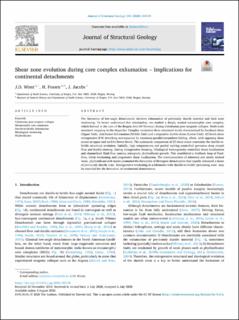| dc.contributor.author | Wiest, Johannes | |
| dc.contributor.author | Fossen, Haakon | |
| dc.contributor.author | Jacobs, Joachim | |
| dc.date.accessioned | 2021-03-18T09:28:25Z | |
| dc.date.available | 2021-03-18T09:28:25Z | |
| dc.date.created | 2020-11-28T13:18:10Z | |
| dc.date.issued | 2020 | |
| dc.identifier.issn | 0191-8141 | |
| dc.identifier.uri | https://hdl.handle.net/11250/2734088 | |
| dc.description.abstract | The formation of low-angle detachments involves exhumation of previously ductile material and fault zone weakening. To better understand this relationship, we studied a deeply eroded metamorphic core complex, which formed in the core of the Bergen Arcs (W Norway) during Caledonian post-orogenic collapse. Multi-scale structural mapping in the Øygarden Complex constrains three structural levels characterized by localized shear (Upper Unit), distributed deformation (Middle Unit) and a migmatite double-dome (Lower Unit). All levels show retrogressive E-W stretching accompanied by extension-parallel recumbent folding, albeit, with opposing shear senses at upper and middle/lower levels. The systematic comparison of 23 shear zones constrains the ductile-to-brittle structural evolution. Initially, high temperatures and partial melting controlled pervasive deep crustal flow and ductile doming. During retrogressive shearing, lithological heterogeneity controlled strain localization and channelized fluid flow causing retrograde phyllosilicate growth. This established a feedback loop of fluid-flow, fabric weakening and progressive shear localization. The interconnection of inherited and newly formed weak, phyllosilicate-rich layers promoted the formation of bivergent detachments that rapidly exhumed a dome of previously ductile crust. Retrogressive weakening in a kilometer-wide ductile-to-brittle ‘processing zone’ may be essential for the formation of continental detachments. | en_US |
| dc.language.iso | eng | en_US |
| dc.publisher | Elsevier | en_US |
| dc.rights | Navngivelse 4.0 Internasjonal | * |
| dc.rights.uri | http://creativecommons.org/licenses/by/4.0/deed.no | * |
| dc.title | Shear zone evolution during core complex exhumation – Implications for continental detachments | en_US |
| dc.type | Journal article | en_US |
| dc.type | Peer reviewed | en_US |
| dc.description.version | publishedVersion | en_US |
| dc.rights.holder | Copyright 2020 The Authors. | en_US |
| dc.source.articlenumber | 104139 | en_US |
| cristin.ispublished | true | |
| cristin.fulltext | original | |
| cristin.qualitycode | 2 | |
| dc.identifier.doi | 10.1016/j.jsg.2020.104139 | |
| dc.identifier.cristin | 1853645 | |
| dc.source.journal | Journal of Structural Geology | en_US |
| dc.identifier.citation | Journal of Structural Geology. 2020, 140, 104139. | en_US |
| dc.source.volume | 140 | en_US |

